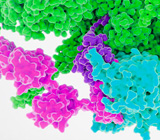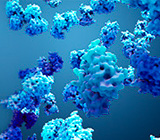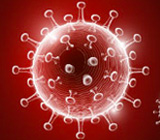-
REAGENT SERVICES
Hot!
-
Most Popular Services
-
Molecular Biology
-
Recombinant Antibody/Protein
-
Reagent Antibody
-
CRISPR Gene Editing
-
DNA Mutant Library
-
IVT RNA and LNP Formulations
-
Oligo Synthesis
-
Peptides
-
Cell Engineering
-
- CRISPR/Cas9 sgRNA
- CRISPR/Cas12a crRNA
- Prime Editing Guide RNA
- Base Editing Guide RNA
- HDR Templates
- gRNA + HDR Template Design Tools
- cGMP Guide RNA
- cGMP HDR Templates
- CRISPR/Cas Proteins
- CAR-T Knock-in Optimization Kit
- CRISPR Plasmids
- CRISPR gRNA Plasmid Libraries
- CRISPR Cell Lines
- Microbial Genome Editing
-
-
PRODUCTS
-
Most Popular Reagents
-
 Instruments
Instruments
-
Antibodies
-
ELISA Kits
-
Protein Electrophoresis and Blotting
-
Protein and Antibody Purification
-
Recombinant Proteins
-
Molecular Biology
-
Stable Cell Lines
-
Cell Isolation and Activation
-
 IVD Raw Materials
IVD Raw Materials
-
 Therapy Applications
Therapy Applications
-
Resources
-
- Pharmacokinetics and Immunogenecity ELISA Kits
- Viral Titration QC ELISA Kits
- -- Lentivirus Titer p24 ELISA KitHot!
- -- MuLV Titer p30 ELISA KitNew!
- -- AAV2 and AAVX Titer Capsid ELISA Kits
- Impurity Test ELISA Kits
- -- BSA ELISA Kit, 2G
- -- Cas9 ELISA KitNew!
- -- Protein A ELISA KitNew!
- -- His tagged protein detection & purification
- -- dsRNA ELISA Kit
- -- Endonuclease ELISA Kit
- COVID-19 Detection cPass™ Technology Kits
-
- Automated Maxi-Plasmid PurificationHot!
- Automated Mini-Plasmid PurificationNew!
- PCR Reagents
- S.marcescens Nuclease Benz-Neburase™
- DNA Assembly GenBuilder™
- Cas9 / Cas12a / Cas13a Nucleases
- Base and Prime Editing Nucleases
- GMP Cas9 Nucleases
- CRISPR sgRNA Synthesis
- HDR Knock-in Template
- CRISPR Gene Editing Kits and Antibodies
-
![AmMag™ Quatro Automated Plasmid Purification]() AmMag™ Quatro automated plasmid purification
AmMag™ Quatro automated plasmid purification
-
![Anti-Camelid VHH]() MonoRab™ Anti-VHH Antibodies
MonoRab™ Anti-VHH Antibodies
-
![ELISA Kits]() ELISA Kits
ELISA Kits
-
![Precast Gels]() SurePAGE™ Precast Gels
SurePAGE™ Precast Gels
-
![Quatro ProAb Automated Protein and Antibody Purification System]() AmMag™ Quatro ProAb Automated Protein and Antibody Purification System
AmMag™ Quatro ProAb Automated Protein and Antibody Purification System
-
![Target Proteins]() Target Proteins
Target Proteins
-
![AmMag™ Quatro Automated Plasmid Purification]() AmMag™ Quatro automated plasmid purification
AmMag™ Quatro automated plasmid purification
-
![Stable Cell Lines]() Stable Cell Lines
Stable Cell Lines
-
![Cell Isolation and Activation]() Cell Isolation and Activation
Cell Isolation and Activation
-
 IVD Raw Materials
IVD Raw Materials
-
![Quick
Order]() Quick Order
Quick Order
-
![Quick
Order]() Quick Order
Quick Order
- APPLICATIONS
- RESOURCES
- ABOUT US
- SIGN IN My Account SIGN OUT
- REGISTER

![Amino Acid Code Amino Acid Code]()
Biology Terms Dictionary
This Biology terms dictionary provides query services for biology and biochemistry terms. Please enter the biology or biochemistry terms you want to search.
List by Alphabet: A B C D E F G H I J K L M N O P Q R S T U V W X Y Z
Standard IgG
Introduction
Immunoglobulin G (IgG) is the most abundant antibody isotype in human serum, accounting for about 70-80% of total immunoglobulins. It plays a crucial role in the adaptive immune system by neutralizing pathogens, facilitating opsonization, and activating the complement cascade. IgG molecules are monomeric antibodies with two identical antigen-binding sites, making them highly specific and versatile. Standard IgG is widely studied and used as a therapeutic and diagnostic tool due to its robust immune functions, long half-life, and well-characterized structure.
IgG is also the basis for many therapeutic antibodies, including monoclonal antibodies (mAbs), which are produced using recombinant technologies. These properties make IgG a cornerstone of antibody-based research, diagnostics, and therapies.
Structure of Standard IgG
IgG molecules have a Y-shaped structure composed of:
- Two Heavy Chains
Each heavy chain contains a variable region (VH) responsible for antigen binding and constant regions (CH1, CH2, CH3). - Two Light Chains
The light chains are also divided into variable (VL) and constant regions (CL), which pair with the heavy chains to form antigen-binding domains. - Fab Region (Fragment Antigen-Binding)
The Fab region contains the VH and VL domains, forming two identical antigen-binding sites. The antigen-binding specificity is determined by complementarity-determining regions (CDRs) within the variable domains. - Fc Region (Fragment Crystallizable)
The Fc region, composed of CH2 and CH3 domains, interacts with Fc receptors (FcγRs) on immune cells and the complement system, mediating effector functions such as ADCC and CDC. The Fc region also binds to neonatal Fc receptors (FcRn), extending the IgG’s half-life in circulation.
Subclasses of IgG
Human IgG is divided into four subclasses, each with distinct biological properties:
- IgG1
Most abundant subclass; highly effective in neutralization and ADCC. Used in many therapeutic monoclonal antibodies. - IgG2
Primarily involved in responses to carbohydrate antigens. Less efficient at FcγR binding and immune activation. - IgG3
Highly potent in complement activation but has a shorter half-life compared to other subclasses. - IgG4
Has unique anti-inflammatory properties and does not trigger ADCC or CDC. Often found in chronic inflammatory conditions.
Mechanisms of Action
- Antigen Neutralization
IgG antibodies bind to toxins or viral particles, preventing them from interacting with host cells. - Opsonization
IgG coats pathogens, marking them for phagocytosis by macrophages and neutrophils through interaction with Fcγ receptors (FcγRs). - Antibody-Dependent Cellular Cytotoxicity (ADCC)
IgG triggers the killing of infected or cancerous cells by engaging natural killer (NK) cells through FcγRs. - Complement Activation (CDC)
IgG molecules activate the classical complement pathway, resulting in membrane attack complex (MAC) formation and target cell lysis. - Half-Life Extension via FcRn Recycling
Binding to neonatal Fc receptors (FcRn) prevents degradation and recycles IgG, giving it a half-life of about 21 days in humans.
Applications of Standard IgG
- Therapeutic Monoclonal Antibodies
IgG is the backbone of monoclonal antibody therapeutics used in cancer immunotherapy (e.g., trastuzumab), autoimmune disease treatment (e.g., infliximab), and infectious disease management. - Passive Immunization
IgG-based therapies, such as intravenous immunoglobulin (IVIG), provide passive immunity by delivering a broad range of antibodies to patients with immune deficiencies or autoimmune diseases. - Diagnostics and Research Tools
IgG is widely used in ELISA assays, immunohistochemistry (IHC), Western blotting, and biosensors to detect specific antigens or proteins. - Vaccine Development
IgG responses serve as the primary indicator of immunity in vaccine studies, including vaccines for viral infections like COVID-19 and influenza.
Advantages of IgG
- Long Half-Life: The FcRn-mediated recycling pathway extends IgG’s half-life, ensuring sustained immune responses and prolonged therapeutic effects.
- Effector Functions: IgG can trigger ADCC, CDC, and phagocytosis, enhancing immune clearance of pathogens or cancer cells.
- Versatility and Scalability: Recombinant IgG antibodies are easily produced in mammalian cell lines (e.g., CHO or HEK293 cells), ensuring scalability for research and therapeutic use.
- Reduced Immunogenicity: Humanized and fully human IgG antibodies minimize the risk of immune reactions in patients, improving safety.
Challenges and Limitations
- Production Costs: Producing therapeutic-grade IgG in mammalian systems (e.g., CHO cells) can be expensive due to the need for complex media and long culture periods.
- Glycosylation Variability: Inconsistent glycosylation on the Fc region can affect antibody function and therapeutic efficacy.
- Immunogenicity: Although humanized IgG antibodies reduce immunogenicity, some patients may still develop anti-drug antibodies (ADAs), reducing treatment effectiveness.
- Limited Tissue Penetration: The large size of IgG (~150 kDa) restricts its penetration into certain tissues, limiting its effectiveness in some therapeutic applications.
GenScript Services and Solutions
GenScript provides a wide range of services for IgG development and production:
- Custom Antibody Production: High-quality production of monoclonal and polyclonal IgG antibodies using mammalian expression systems.
- Humanization and Fc Engineering: GenScript offers antibody humanization and Fc optimization to enhance effector functions and reduce immunogenicity.
- Antibody Purification and Analytics: Advanced purification methods and analytical tools ensure high purity and functional integrity.
- Stable Cell Pool & Cell Line Platform: GenScript provides high expression levels for high-quality antibodies with fast turnaround times.
Conclusion
Standard IgG is a critical component of the immune system and serves as the foundation for many diagnostic and therapeutic applications. Its well-defined structure, effector functions, and extended half-life make it an ideal candidate for monoclonal antibody development and passive immunization therapies. Despite challenges related to production costs, glycosylation variability, and tissue penetration, advances in antibody engineering, bioprocessing, and AI-based design are driving the next generation of IgG-based biologics. As these innovations continue, IgG antibodies will remain at the forefront of immunotherapy and biomedical research.
Related Article
What are the Different Bispecific Antibody Formats?
The Structure and Function of Antibodies | GenScript
- Tags:
- Protein
Related Biology Tools
-
GenSmart™ Codon Optimization
GenSmart Optimization is a free online tool for performing codon optimization to improve gene expression. GenScript's patented algorithms are integrated into the tool to optimize the computing capability of high-performance sequence generation.
-
DNA Construct Design Tool
GenSmart™ Design is a free online DNA construct design tool developed by GenScript. GenSmart™ Design has two design modules, the Create Construct module for individual plasmid design and the Create Library module for DNA library design.
-
Codon Frequency Tables
This online tool shows commonly used genetic codon frequency table in expression host organisms including Escherichia coli and other common host organisms.
Service and Products

Protein Expression
GenScript recombinant protein and rAb services provide high quality recombinant proteins and rAbs for a variety of downstream research applications.

Bacterial Expression
One-stop service from Sequence to Protein starting from $1600, 4 weeks.

Insect Expression
GenScript's BacuVance baculovirus expression system was developed by our in-house team of scientists for virus production and expression of recombinant proteins from baculovirus-infected insect cells.

Mammalian Transient Expression
Proprietary High Density (HD) expression system, enhance the protein yield up to 100 fold, achieve antibody titers up to 3 g/L.

Reagents for COVID-19 Research
Gram level, ready to ship RBD proteins, ACE2 assay cell lines and pseudovirus.
-
Top Search
-
Hot Glossary
-
Antibody
If you know of any terms that have been omitted from this glossary that you feel would be useful to include, please send detail to the Editorial Office at GenScript: website@genscript.com
If your term is adopted, we will send 1,000 EzCoupon points to your GenScript account.
-





































